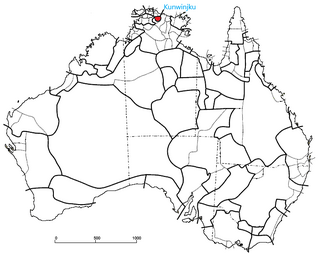
The Ngarinyin language, also known as Ungarinjin and Eastern Worrorran, is an endangered Australian Aboriginal language of the Kimberley region of Western Australia spoken by the Ngarinyin people.

The Kunwinjku people are an Australian Aboriginal people, one of several groups within the Bininj people, who live around West Arnhem Land to the east of Darwin, Northern Territory. Kunwinjku people generally refer to themselves as "Bininj" in much the same way that Yolŋu people refer to themselves as "Yolŋu".

The Bunuba are a group of Indigenous Australians and are one of the traditional owners of the southern West Kimberley, in Western Australia. Many now live in and around the town of Fitzroy Crossing.
Keiadjara, also rendered Kiyajarra, were an Aboriginal Australian people of the Pilbara region of Western Australia.
The Murunitja are an indigenous Australian tribe of Western Australia located within the Goldfields-Esperance region.
The Atjinuri were an indigenous Australian people of the Cape York Peninsula of Queensland.
The Banbai are an Indigenous Australian people of New South Wales.
The Miwa are an Aboriginal Australian people of the Kimberley region of Western Australia.
The Wirngir are an Aboriginal Australian people of the Kimberley region of Western Australia.
The Arnga are an Aboriginal Australian people of the northern Kimberley region of Western Australia.
The Wilawila are an indigenous Australian tribe of the Kimberley region of Western Australia.

The Wunambal (Unambal), also known as Wunambal Gaambera, Uunguu, and other names, are an Aboriginal Australian people of the northern Kimberley region of Western Australia.
The Ngardi, also spelled Ngarti, are an Aboriginal Australian people of the Northern Territory and Western Australia.
The Jabirr Jabbirr are an Aboriginal Australian people of the Kimberley region of Western Australia.

The Nyulnyul, also spelt Nyul Nyul, Njolnjol, Nyolnyol and other variants, are an Aboriginal Australian people of the Kimberley region of Western Australia.
The Malngin are an Aboriginal Australian people of the Kimberley region of Western Australia. The Malngin language was a dialect of Gurindj.
The Ngathokudi (Ngadhugudi) were an indigenous Australian people of the state of Queensland. Their language was possibly a dialect of Uradhi.
The Yungkurara were an indigenous Australian people of the state of Queensland.
The Gungorogone are an indigenous Australian people of the Northern Territory.
The Yindjilandji are an indigenous Australian people of the Northern Territory.